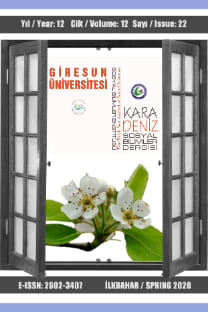Hikmetlerin Dilinden Hoca Ahmed Yesevî
Hoca Ahmed Yesevî’nin halkın anlayabileceği bir dil ve hece vezniyle dörtlükler
Anahtar Kelimeler:
Hikmet, Ahmed Yesevî, şerîat, tarîkat, tasavvuf
From Language Of Wisdoms Hodja Ahmad Yasawi
The poems of Hoca Ahmed Yesevî (Khoja Akhmet Yassawi) are called “hiqmet”,written in stanza form and syllabic meter with a languge that the people canunderstand. Yesevî aims at teaching the people manners of order, religous-suficsubjects with his hikmets. Teaching some important subjects in simple poetic formwith meter and rhyme is a method that has been tried by many writers andintellectuals, which has given positive/useful results in different periods of history.The success of the method lies in the easy memorization of measured and rhymedstatements that sticks in the mind. The Quran whose verses end with sounds that canbe regarded as prose rhyme is the best example affirming this opinion. Written infourteenth century, Mu‘înu’l-Murîd by Sheikh İslam is also a poetic work aiming toteach the people the rules of Islam and pillars of faith in stanzaic form. We also seethe background thoughts of Yesevî’s hiqmets in early twentieth century author ZiyaGökalp’s prose and poetry. Gökalp thinks that national epics, Turkish folk tales andlegends, religio-mythical and historical topics can be taught easily with metrical andryhmed sayings. These humanistic and moral thoughts taught in poetic form led todescribing him as a sheikh coming from Khorasan or Uzbekistan. Yesevî deals withdifferent religious-sufic topics in his hiqmets in Dîvân. It can be said that the maintopics of his hiqmets are sharia rules, the sunna of Prophet Muhammad, love of theprophet, the manners of Yesevî order, traditions-customs and conventions, love andsigns, difficulties of love etc. Among these, love is the reason for the change inAhmed-i Yesevî’s life. Reaching beloved and eternal happiness is only possiblethrough love.
Keywords:
Hiqmet, Ahmed Yesevî, sharia, order, sufism,
___
- Ahmedî Divanından Seçmeler, (1998), Haz.: Yaşar Akdoğan, Kültür ve Turizm Bakanlığı Yay., Ankara.
- Alparslan, Prof. Dr. Ali; (2000), Kadı Burhaneddin Divanı’ından Seçmeler, Kültür Bak. Yay., Ankara,
- Banarlı, Nihad Sâmi; (1998), Resimli Türk Edebiyatı Tarihi I, MEB Yay., ME Bs. Evi, İstanbul. Eraslan, Prof. Dr. Kemal; (1991), Ahmed-i Yesevî, Dîvân-ı Hikmet’ten Seçmeler, Kültür Bakanlığı Yay., Ankara.
- Fuzûlî Dîvânı; (1990), Metni baskıya haz.: Prof Kenan Akyüz-Süheyl Beken-Doç. Dr. Sedit Yüksel-Dr. Müjgan Cunbur, Akçağ Yay., Ankara.
- Kaplan,Mehmet; (1987), Türk Edebiyatı Üzerinde Araştırmalar 2, dergâh yay.,İstanbul.
- Nesîmî Divanı; (1990), Yay. Haz.: Dr. Hüseyin Ayan, Akçağ Yay, Ankara.
- Türk Dili ve Edebiyatı Ansiklopedisi (TDE Ans.); dergâh yay., C 1, İstanbul.
- Türkiye Dışındaki Türk Edebiyatları Antolojisi (TDTEA) - Özbek Edebiyatı, (2000), Kültür Bakanlığı, C 14, Ankara.
- Uludağ, Prof. Dr. Süleyman; (1995), Tasavvuf Terimleri Sözlüğü, Marifet Yay., 2.bs., İstanbul.
- Üzgör, Tahir; (1991), Fehîm-i Kadîm (Hayatı, Sanatı, Dîvân’ı ve Metnin Bugünkü Türkçesi), AKDTYK AKM Yayını, Ankara.
- Kültürümüzde Âyet ve Hadisler (Ansiklopedik Sözlük), (2013), Haz.: Mehmet Yılmaz, Kesit yay., İstanbul.
- Yûnus Emre Divanı II Tenkitli Metin; (1991), Haz.: Dr. Mustafa Tatçı, Akçağ Yay., Ankara.
- ISSN: 2602-3407
- Yayın Aralığı: Yılda 2 Sayı
- Başlangıç: 2009
- Yayıncı: -
Sayıdaki Diğer Makaleler
İlköğretim Öğrencilerinde Proje Tabanlı Mikroskobik Canlı Bilincinin Oluşturulması
SERPİL UĞRAŞ, HASAN KAĞAN KESKİN, NİSA SİPAHİ, Hacer DURSUN
XIX. Yüzyılın Sonlarında Elviye-i Selâse’de Karayolu Yapım Faaliyetleri
Evde Eğitim Uygulaması Üzerine Bir Durum Çalışması: Evde Fen Eğitimi
İyi Tarım Uygulamaları: Migros Ticaret Anonim Şirketi Örneği
Alıştırmalardan Etkinliklere: Eğitimdeki Gelişmeler
2008 Küresel Krizi ve Değişen Para Politikaları: Dünyada ve Türkiye’de Faiz Koridoru Uygulaması
ESRA KARABAĞ KÖSE, NEZAHAT GÜÇLÜ
Cumhuriyet Döneminde Rize Türk Ocakları (1924-1931)
Sözlü Kültür Ortamında Derlenen Mukaddem Ali Destanındaki Tarihî Gerçeklik
